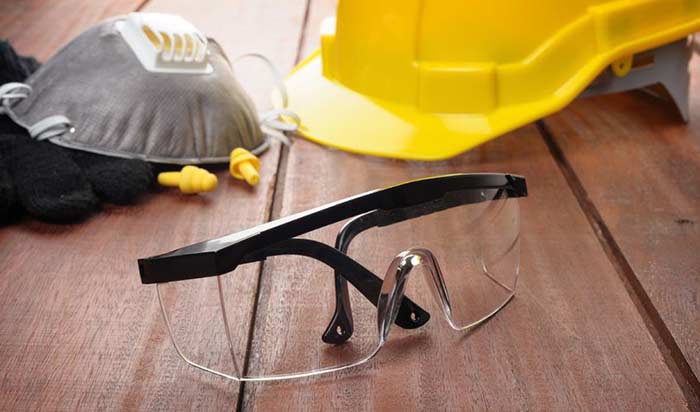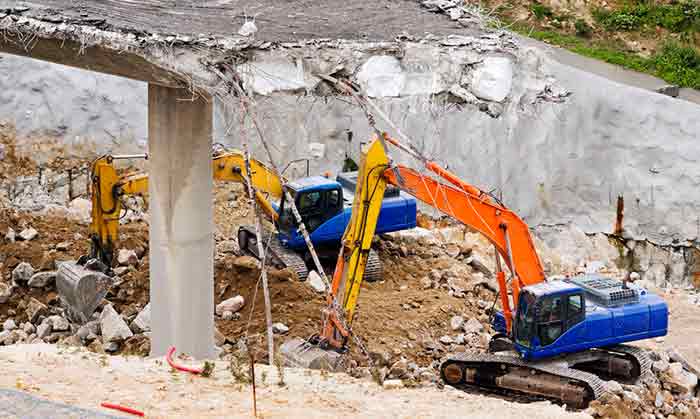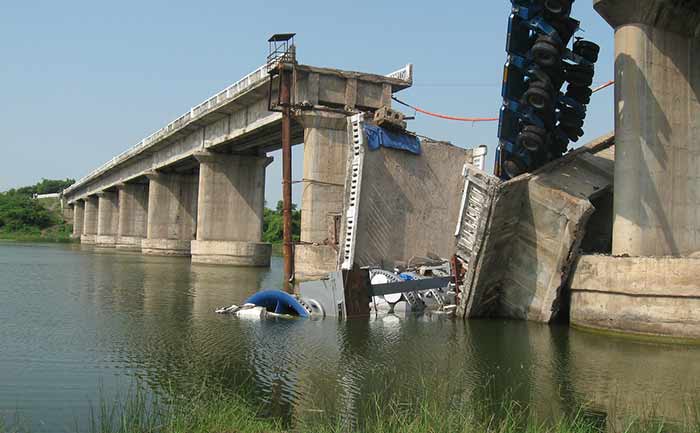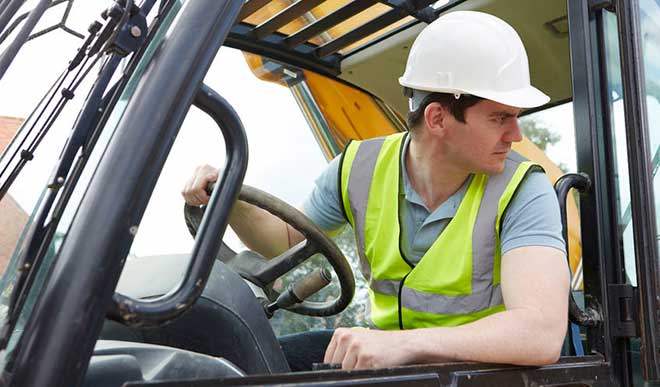Almost every year since 2000, one major bridge has collapsed in the United States. Beyond major incidents, 228 bridges on average fail each year.
Many of these failures are due to violent weather. Almost two hurricanes on average make landfall in the United States annually, causing damage to bridges and road infrastructure. Many states, including Florida, Louisiana, Alabama, Texas, Georgia, North Carolina, South Carolina and Virginia bear the brunt of this.
In addition, every year over the last 60 years, between 15 and 135 tornadoes in the U.S. were violent enough to damage roads, bridges and related structures. And on average, 15 earthquakes annually are strong enough to cause infrastructure damage.
Risks for workers
When a bridge is damaged or destroyed because of an accident, extreme weather event or a natural disaster, emergency workers step in immediately to help save lives, secure the structure and eventually demolish, repair or rebuild it.
Unfortunately, many of these workers end up with injured. According to data from The Federal Highway Administration, one work zone injury happens every 14 minutes (over 102 per day). That translates to approximately four people injured every hour.
These brave and selfless emergency workers — including divers, equipment operators, bridge inspectors and maintenance and construction workers — must be kept safe on compromised bridge sites.
Let’s look at the most significant risks workers face in a bridge emergency, and what can be done to keep them safe.
Basic protection for workers
According to OSHA, the Occupational Safety and Health Administration, employees must be supplied with protective equipment while working on a bridge repair or construction site. This is particularly important when they’re doing work on a bridge compromised by an accident or natural disaster.

Basic level protection includes:
- Hard hats to shield workers from things falling from above, or that they could run into head on. They must also protect against electrical hazards, including power lines, connectors and other electrical equipment.
- Eye protection with side shields to safeguard against bright light, smoke, poking and scratches.
- Gloves specially designed for hazards like handling, pipes, wires chemicals, and debris with sharp edges.
- ANSI-approved protective footwear to guard against slips, falls and stepping on or over glass and debris with jagged edges.
- Respiratory protection against things like dust, silica, dried mud, dirt, silt and odors.
Initial emergency precautions
When an emergency hits, workers should already have a default plan of action to work with. We’ve laid out these immediate steps as a linear process:
- Limit access to the bridge.
- Conduct a survey.
- Shore up the structure.
- Plan for immediate demolition if necessary.
1. As soon as a bridge emergency occurs, inspectors and engineers must work closely with police and local transportation workers to limit access to the damaged bridge. They must have a complete understanding of its structural integrity before proceeding. Based on an initial review, they should set up controlled access zones so emergency workers can enter the bridge at the safest locations to help injured people and take steps to limit further injuries or physical damage.
2. The next step is to conduct an engineering survey of the structure and take immediate steps to shore it up. Roads, entrance and exit ramps and any other adjacent structures that might have been impacted should be inspected and evaluated as well. Bridges don’t exist in isolation. They are part of an interconnected infrastructure. Damage to related structures could eventually affect the bridge.
3. As soon as inspectors and engineers identify issues, they must work closely with construction and road maintenance workers to install temporary structural support, including shoring and bracing, to protect response and recovery workers.
4. If the initial survey shows the bridge or related structures need to be demolished immediately, engineers should develop a written plan that explains how the structure will be dismantled safely.
The reality is, things don’t always happen this way in an emergency; they will likely take place all at once. That’s why it’s important for everyone in a municipality to meet regularly to discuss and plan for emergencies. This is a best practice that can help avoid chaos when you can least afford it: during a bridge emergency.
Using heavy equipment, cranes and lifts

Many of these tips are best practices for using heavy equipment on a bridge construction site all the time. It’s particularly important to follow them when a site is compromised:
- Ensure all vehicles have service, emergency and parking brake systems that are tested regularly. The last thing anyone needs in an emergency is a heavy equipment accident to complicate things.
- Check that all head, tail, and brake lights are working. It can help the equipment drivers to see emergency workers and the workers to see the vehicle. This is especially important when visibility is limited by construction debris, smoke or dust.
- Make sure vehicles have an audible warning device, such as a horn, in good working condition. Drivers must be able to warn or signal others in the chaos of a bridge emergency.
- Check that windshields aren’t cracked or damaged and that vehicles have working windshield wipers. If a damaged windshield is hit by debris during an emergency, it could shatter, causing an accident or injury to the driver. Windshield wipers are necessary if work happens during foul weather (a common cause of bridge-related emergencies), if water is sprayed to put out a fire or reduce airborne dust, or pipes are leaking water or chemicals.
- Ensure that all vehicles have rollover protection. This is particularly important if equipment is used on compromised roads, damaged entrance or exit ramps and littered river beds.
- Never exceed manufacturer equipment limits. This can be a temptation in an emergency, but it is never a good idea to push the limit. It could cause accidents or equipment failure, which can make a crisis situation worse.
Finally, check that all operators have been trained on the equipment they use. Remember to include special training on how to handle emergencies. Operators should be required to attend “refresher” training on a regular basis. It’s easy for operators to forget things over time and revert to bad habits. The National Association of Heavy Equipment Training Schools can help you find a resource in your area.
Another best practice is to inspect all vehicles at the beginning of each shift to ensure that the parts, equipment, and accessories discussed above are in safe operating condition. (OSHA offers a list of things that should be checked.) Repair or replace any defective parts or equipment prior to use.
Tip: Require that workers always use safety belts and follow safety guidelines. If they work safely all the time, they will likely continue to do so in emergency situations.
Falling objects
Emergency-related damage doesn’t happen all at once. Bridges and related structures continue to degenerate long after a storm, earthquake, accident or other emergency is over. That’s why it’s important to secure and remove glass, loose structural pieces and other objects that could fall on emergency, maintenance and construction workers. Also, as soon as possible, install debris netting, sidewalk sheds, canopies or catch platforms to reduce hazards from falling objects.
Did you know? On average, according to the Centers for Disease Control, 669 road workers each year die in work-related accidents. Taking proactive protective measures could prevent many of these.
Utility-related issues

The nation’s bridges are lined with thousands of miles of power cables, gas lines, water pipes and other utility conduits. This can create very serious hazards for anyone working on a compromised bridge site. Here are steps that can be done to protect workers and the general public from utility-related accidents on a bridge emergency site.
- Always assume that electrical lines are energized until it is confirmed they are not. This practice should continue even after the emergency situation is over. That’s because cables, conductors and other equipment often become reenergized without warning as utilities are evaluated and restored after a disaster.
- Immediately inspect the crisis area for downed conductors and don’t allow anyone to go near, drive over, or otherwise come in contact with them. Immediately have experts isolate and control them.
- Always remember that electrical conductors can energize other objects, including fences, water pipes, bushes, trees, and telephone/CATV/fiber optic cables. Check that all objects are safe before allowing anyone to come in contact with them.
- Unless powered down and visibly grounded, ensure workers maintain proper distance from overhead electrical power lines. The benchmark recommended by OSHA is 10 feet or more.
- Look out for gas leaks and get them repaired immediately. Don’t let anyone near a leak unless they are an experienced professional. If a gas leak is detected, immediately stop everyone from using spark-producing devices such as engines, tools, electronic, and communications equipment. Evacuate the area until the leak is repaired.
The best time to plan for how to handle utility issues during a bridge emergency is before they happen. Bridge management and maintenance people should proactively work with utility companies to locate, mark, and have a plan for shutting off or purging utility lines that could pose a hazard or be impacted during an emergency. This type of planning is particularly important for older bridges that likely have little coordinated documentation.
Falls
Falls from heights or through openings are common during bridge emergencies. Damage can cause new openings that workers may be unaware of. It’s important for bridges to be inspected as soon as possible after an emergency to locate new holes, fissures and gaps.
Action should be taken to limit and control access to such hazards and install fall protection systems including guardrails, safety nets and fall arrest equipment. And it’s always a good practice to guard and cover holes and openings as soon as they are discovered. According to OSHA guidelines, covers must support two times the total combined body, equipment or material weight that they are expected to support.
Tip: Prior to an emergency happening, have a plan in place on where you can get fast access to barriers, road covers and other protection and repair supplies and equipment.
Dust, silica, smoke and other airborne materials
When a bridge is damaged, it usually generates dust and flying debris. The most dangerous is dust from crystalline silica-containing materials, like concrete, brick, tile, drywall, mortar, sand, or stone. When inhaled, the fine crystalline silica particles contained in the dust become lodged deep in the lungs, which can cause silicosis and other respiratory illnesses.
Protect workers against this by keeping them upwind of particles. Next, spray water or mist to control the dust, both during the emergency and after, while the bridge is being torn down or repaired.
If people must work near silica particles, at a minimum, provide respirators with N, R, or P95 or P100 filters. Higher levels of respiratory protection may be needed for some riskier operations, including cutting or mixing concrete or sandblasting. N, R, or P95 respirators should be used for nuisance dusts such as dried mud, dirt, silt and mold (unless there is a significant mold issue). Filters with a charcoal layer can be used for odors.
Remember: Older bridges often contain lead. It’s a smart move in an emergency to protect against lead hazards, even if you don’t know for certain that it is present. OSHA offers comprehensive guidelines on how to deal with lead-related issues.
Water risks

Many bridge emergencies take place over or in water. Anyone navigating around a bridge after a weather incident, accident or natural disaster must be cautious because underwater objects often shift as a result of an incident, creating new and unexpected underwater hazards.
Provide emergency workers with safety equipment, including lifesaving skiffs and ring buoys, as appropriate. All personnel should wear Coast Guard-approved Type I or II personal flotation devices. Watertight boots with steel toes and protective insoles should be worn as needed.
If the water is polluted or contaminated, limit the number of people exposed to it. Ensure that good hygiene, especially hand washing, is practiced by employees working near contaminated water before they eat, drink, and smoke. If clean water is not available to do this, provide an alternative, such as hand sanitizer or sanitizing wipes. Remember cuts and bruises should never come in contact with contaminated water.
Also, plan for facilities that decontaminate divers and their equipment when they finish their shifts. In addition, provide employees who could come in contact with contaminated water or mist with goggles to protect their eyes, respirators if they may breathe in contaminated mist, and watertight boots and gloves to protect their hands and feet.
Workers who are expected to work over, in or near water should receive regular, appropriate training, including how to handle emergency situations.
Unknown chemicals
What if hazardous chemical containers are found or emergency workers come across unexplained leaks? Keep workers away from the area and ban the use of spark-producing devices, such as engines, tools, electronic, and communications equipment, until you know what the chemical is.
Once you understand the chemical you’re dealing with, follow the safety precautions for working around it and removing it from the emergency, construction or demolition site.
Conclusion
The time to plan for bridge-related emergencies is now, before they happen. It can help keep emergency workers and construction workers safe and prevent unnecessary injuries and deaths. OSHA offers guidelines that can help you start building a plan. The next step is to share the guidelines with the community partners you’ll be working with during a bridge crisis. Finally, meet with them to discuss building a customized plan on how you handle bridge emergencies in your community.
To get even more prepared, check out our post 10 Essential Safety Tools for Bridge Workers.

